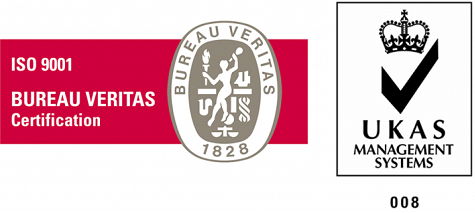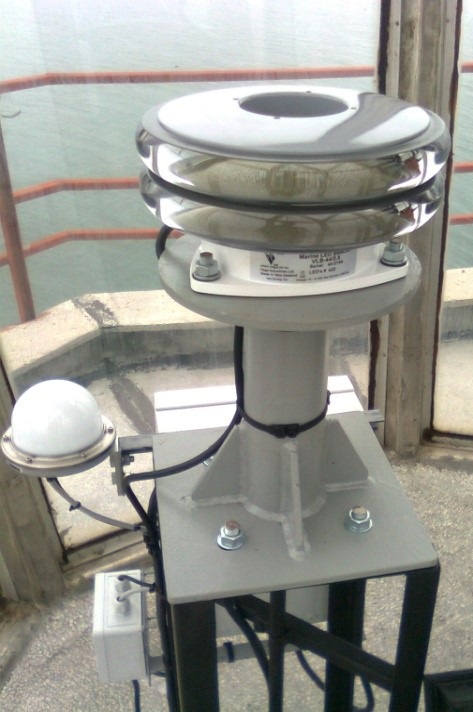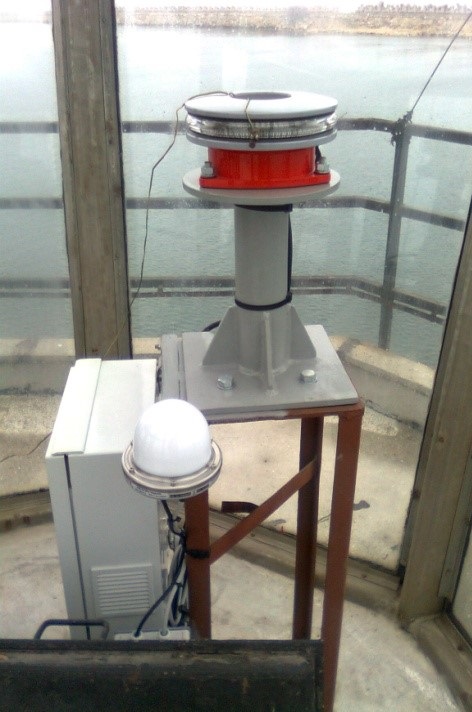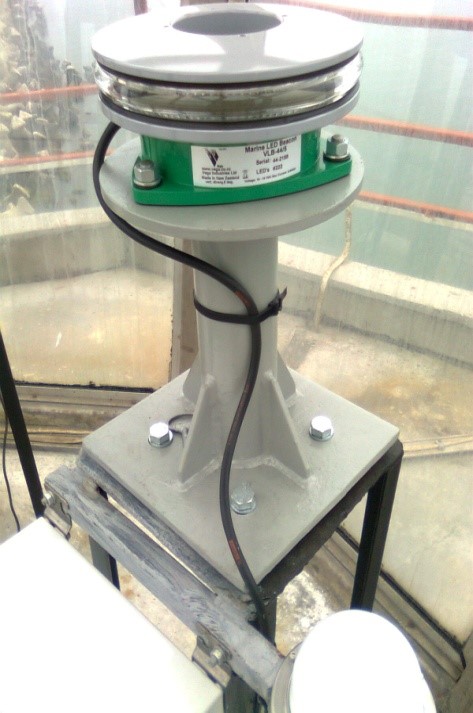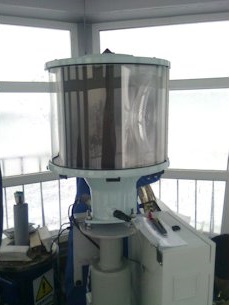Maritime Signalling Equipment
LIGHT APPARATUS VLB 44
VLB-44 is a light apparatus with low power consumption, available in versions with vertical divergence of 2.5 - 5 - and 10 degrees.
The number of floors (1 or 2) and the divergence determine the range between 6 and 10 nautical miles.
Light apparatus of type VLB-44 is designed for operation at a rated voltage of 12Vac and a maximum voltage of 18Vcc.
This light apparatus is supplied with factory programming, but it can be reprogrammed with the IR programmer (remote control), offering a wide range of rhythm and intensity adjustments
VLB-44 can be synchronized by cable with other lights.
Colors of light emitted: Red, Green, White
VLB-44 is a light apparatus with low power consumption, available in versions with vertical divergence of 2.5 - 5 - and 10 degrees.
The number of floors (1 or 2) and the divergence determine the range between 6 and 10 nautical miles.
Light apparatus of type VLB-44 is designed for operation at a rated voltage of 12Vac and a maximum voltage of 18Vcc.
This light apparatus is supplied with factory programming, but it can be reprogrammed with the IR programmer (remote control), offering a wide range of rhythm and intensity adjustments
VLB-44 can be synchronized by cable with other lights.
Colors of light emitted: Red, Green, White
LIGHT APPARATUS VRB 25
Introducere
VRB-25 is a light rotating apparatus, designed for marine buoying for use between 10 and 22 nautical miles. Its energy efficiency and optical quality give it an excellent performance.
Rotating mechanism of VRB-25 exhibits a high level of reliability and resilience. It is equipped with an engine that develops a high torque, controlled by a microprocessor that directly drives the frame / plate / turntable without an intermediate mechanism. The device is mounted on watertight bearings. Rotational speeds are preprogrammed and can be selected by the user. The speed control accuracy is in the order of ± 2%.
A special Fresnel lens system was designed for optimal efficacy. The lenses have a durable construction, each of which is placed in a precision-machined compartment to ensure good alignment.The VRB-25 is omnipotent and can be configured to produce up to a group of 4 light pulses with 6 panels. An option with 8 panels is also possible. It is easy to maintain, operating also with standard industrial lamps. It is equipped with a lamp changer.
Optical system
The optical system is made up of six Fresnel lenses (optionally for eight panels) symmetrically arranged on a frame / turntable around a fixed bulb. Fresnel lenses have a focal length of 178.5 mm to achieve the optimum balance between beam divergence (in elevation and azimuth) and intensity.
Lenses are thick enough to minimize bending and distortion / deformation. Each lens is kept closed in a precision machined compartment, which guarantees that no significant variation in intensity will occur between the adjacent beams. With a focal length of 178.5 mm, there is enough room to include a standard lamp changer, and the lamps are far enough away from the lenses to avoid cooling air pressure. In the absence of cooling air circulation, humidity and atmospheric contaminants are eliminated.
Adjustment is done using simple tools at the top of the beacon. Small alignment holes are perforated on the optical axis of each lens to facilitate alignment of each lamp changer.
Rotary guiding device rotation
The rotary guiding device is driven directly by a low-voltage motor that delivers high torque levels due to its large diameter.
Speed selection is done by two rotary switches. Speed accuracy is ensured at ± 2% of the full speed range.
The rotary/turntable (which includes 6 or 8 panels) is based on two sealed, oversized bearings for a maximum lifetime. The required torque of the drive motor is wide enough to overcome the friction of the hinges / fittings.
Lamps and lamp changer
The VRB-25 has been designed for the use of standard lamps from 10 W to 110 Watts compact halogen.
Day/night transition
The VRB-25 is equipped with a photoelectric (light dependent resistance) detector that detects the ambient light level and illuminates the lamp at dusk. The day/night transition threshold can be adjusted by the user, being factory set to about 100 lux (70 lux ON, 130 lux OFF).
The optical device always operates to prevent any damage caused by focusing sunlight.
Electronic control device
All functions are combined into one control device, CALC-20B. It incorporates speed control, lamp check and correlation, lamp filament control every second, lamp voltage adjustment PWM (modulation of impulses in duration), solar energy switch, and output contact for rotation control. The control unit and the lamp changer are protected against accidental polarity inversions, although the external capacitor is not bipolar.
The lamp does not illuminate if the photoconductor resistance is poor (day sees) or if the speed of the plate/disc is too fast or too slow by 8% compared to the one set by the switches.
Introducere
VRB-25 is a light rotating apparatus, designed for marine buoying for use between 10 and 22 nautical miles. Its energy efficiency and optical quality give it an excellent performance.
Rotating mechanism of VRB-25 exhibits a high level of reliability and resilience. It is equipped with an engine that develops a high torque, controlled by a microprocessor that directly drives the frame / plate / turntable without an intermediate mechanism. The device is mounted on watertight bearings. Rotational speeds are preprogrammed and can be selected by the user. The speed control accuracy is in the order of ± 2%.
A special Fresnel lens system was designed for optimal efficacy. The lenses have a durable construction, each of which is placed in a precision-machined compartment to ensure good alignment.The VRB-25 is omnipotent and can be configured to produce up to a group of 4 light pulses with 6 panels. An option with 8 panels is also possible. It is easy to maintain, operating also with standard industrial lamps. It is equipped with a lamp changer.
Optical system
The optical system is made up of six Fresnel lenses (optionally for eight panels) symmetrically arranged on a frame / turntable around a fixed bulb. Fresnel lenses have a focal length of 178.5 mm to achieve the optimum balance between beam divergence (in elevation and azimuth) and intensity.
Lenses are thick enough to minimize bending and distortion / deformation. Each lens is kept closed in a precision machined compartment, which guarantees that no significant variation in intensity will occur between the adjacent beams. With a focal length of 178.5 mm, there is enough room to include a standard lamp changer, and the lamps are far enough away from the lenses to avoid cooling air pressure. In the absence of cooling air circulation, humidity and atmospheric contaminants are eliminated.
Adjustment is done using simple tools at the top of the beacon. Small alignment holes are perforated on the optical axis of each lens to facilitate alignment of each lamp changer.
Rotary guiding device rotation
The rotary guiding device is driven directly by a low-voltage motor that delivers high torque levels due to its large diameter.
Speed selection is done by two rotary switches. Speed accuracy is ensured at ± 2% of the full speed range.
The rotary/turntable (which includes 6 or 8 panels) is based on two sealed, oversized bearings for a maximum lifetime. The required torque of the drive motor is wide enough to overcome the friction of the hinges / fittings.
Lamps and lamp changer
The VRB-25 has been designed for the use of standard lamps from 10 W to 110 Watts compact halogen.
Day/night transition
The VRB-25 is equipped with a photoelectric (light dependent resistance) detector that detects the ambient light level and illuminates the lamp at dusk. The day/night transition threshold can be adjusted by the user, being factory set to about 100 lux (70 lux ON, 130 lux OFF).
The optical device always operates to prevent any damage caused by focusing sunlight.
Electronic control device
All functions are combined into one control device, CALC-20B. It incorporates speed control, lamp check and correlation, lamp filament control every second, lamp voltage adjustment PWM (modulation of impulses in duration), solar energy switch, and output contact for rotation control. The control unit and the lamp changer are protected against accidental polarity inversions, although the external capacitor is not bipolar.
The lamp does not illuminate if the photoconductor resistance is poor (day sees) or if the speed of the plate/disc is too fast or too slow by 8% compared to the one set by the switches.




